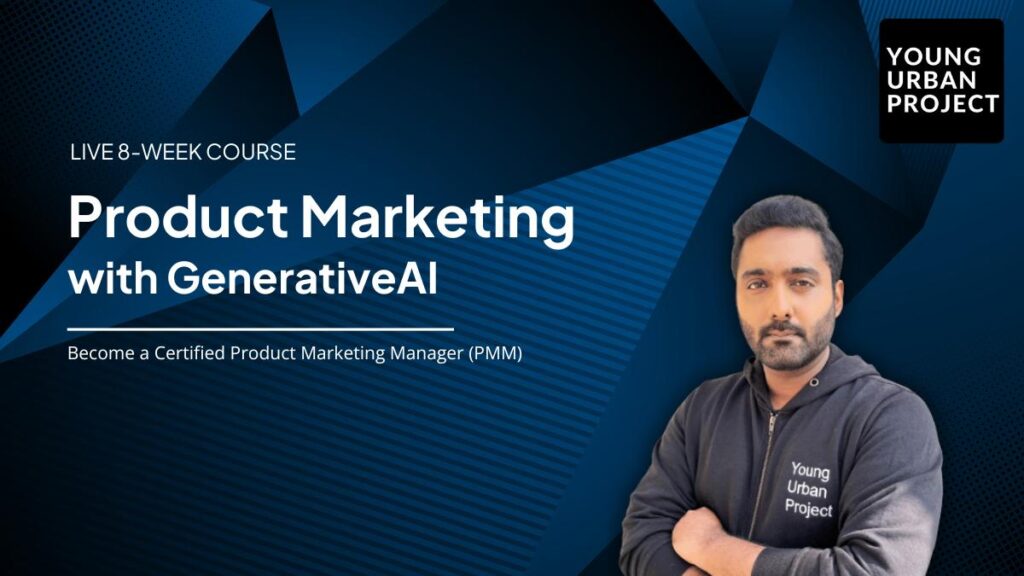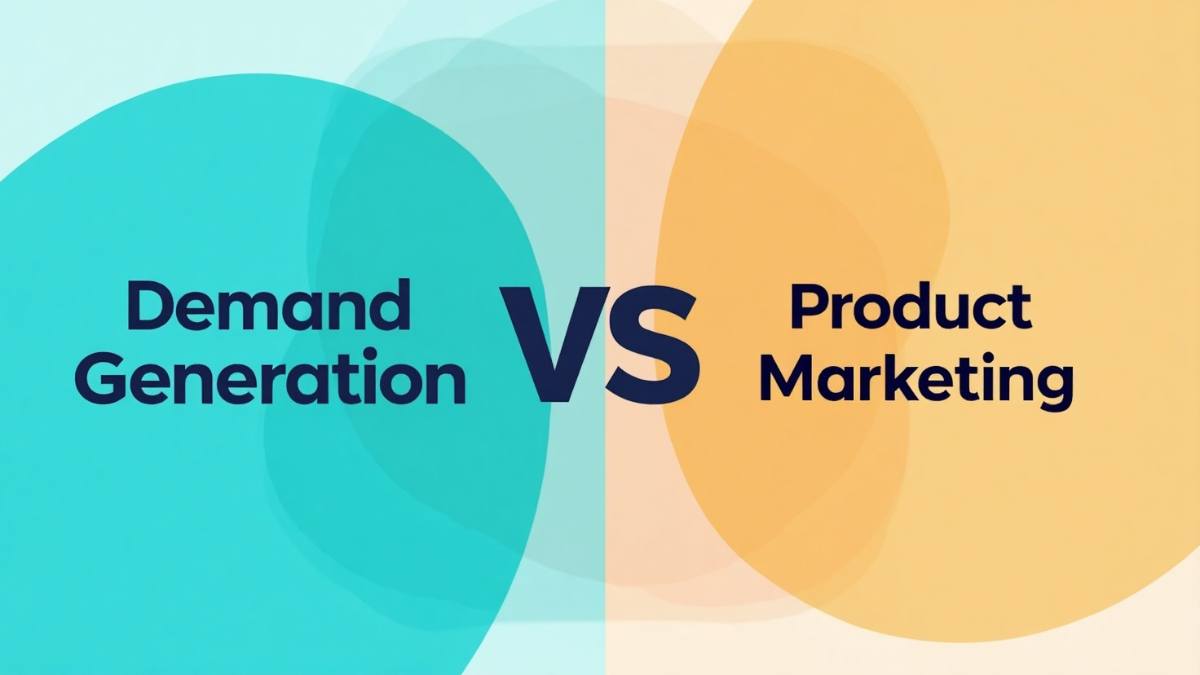Demand gen. Product marketing. Same thing, right?
Not quite.
Mixing the two might seem harmless, but in reality, it’s one of the most common reasons campaigns underperform, messaging falls flat, and leads don’t convert.
If you’ve worked on a growing marketing team, you’ve likely seen the confusion firsthand:
Who’s bringing in the leads? Who’s shaping the story?
And where does one role end and the other begin?
Even with AI changing how we approach marketing, this mix-up isn’t new. These two functions have been blurred for years, often bundled under one title, or handed off to a single person wearing too many hats.
Here’s a simple way to look at it:
- Demand generation is focused on building interest and getting people into your funnel.
- Product marketing is focused on telling the product’s story in a way that gets people to say yes, and keeps them coming back.
They work differently. But when they work together, that’s when real growth happens.
Table of Contents
Introduction
In day-to-day marketing, the lines between demand generation and product marketing often get blurred. It’s common for teams to expect one person to handle both, creating awareness, bringing in leads, and also owning the product messaging.
At first glance, that sounds efficient. But over time, it creates problems. The messaging doesn’t always match the audience. Campaigns generate clicks but not conversions. And sales ends up with leads that aren’t quite ready, or don’t understand what the product really does.
That’s why drawing a clear line between the two roles matters.
When each function has its focus, and both teams work together, everything flows better. The message is tighter. The campaigns perform stronger. And prospects move through the funnel with less friction.
You don’t need more content or bigger budgets, you just need clarity on who’s doing what, and how both sides can support each other.
What is Product Marketing?
Product marketing is what connects your product to the people who need it, in a way that actually makes sense to them.
It’s not just about launching new features or writing a catchy headline. It’s about getting to know your customer, really understanding your product, and making sure the message in between clicks.
What do product marketers actually do?
- They shape the message. They figure out how to explain the product so it hits home.
- They support sales. That means creating decks, one-pagers, and anything the sales team needs to close deals.
- They drive adoption. Even after someone buys, they make sure people actually use and stick with the product.
Product marketers mostly work in the middle to bottom of the funnel, the “how do we get people to buy and stay?” part. They’re key in turning curious leads into happy customers.
Who usually owns this?
Product Marketing Managers (PMMs).
They usually sit close to product, sales, and content teams. Their job is to act like a translator, turning what the product can do into something the customer wants to hear.
Also Read: How to Become a Successful Product Marketing Manager
What is Demand Generation?
If product marketing tells the story, demand generation gets people to show up and listen.
This is the team that builds buzz, drives interest, and brings in leads. They’re responsible for filling the pipeline, and keeping it moving.
What do demand gen folks focus on?
- Getting the word out. They run campaigns that put your brand in front of the right people.
- Capturing interest. Through ads, content, events, or downloads, they make people raise their hand.
- Nurturing leads. They make sure people don’t forget you after that first click, with email, retargeting, or more content.
Demand gen usually works across the entire funnel, but especially the top and middle parts, where you’re turning strangers into prospects, and prospects into sales-ready leads.
Who runs demand gen?
You’ll usually see growth marketers, demand gen specialists, or revenue marketers leading this.
They partner with paid media folks, content teams, and sales, basically anyone who touches the lead journey, to make sure leads don’t just come in… they move forward.
Also Read: 10 Creative Product Launch Ideas
Difference between Demand Generation and Product Marketing
While they work hand-in-hand, the focus, metrics, and tactics of each role differ significantly.
| Feature | Demand Generation | Product Marketing |
| Strategic Focus | Short-term pipeline growth | Long-term product positioning |
| Main Metrics | MQLs, SQLs, CPL, pipeline velocity | Product adoption, retention, win/loss analysis |
| Key Tactics | Email campaigns, paid ads, webinars | Messaging docs, sales enablement, launch strategy |
| Buyer Stage Targeting | Full funnel, esp. top + mid | Consideration through retention |
| Internal Collaboration | Sales, performance, content | Product, sales, content, success |
| Messaging vs Activation | Activates campaigns based on messaging | Owns and refines the messaging |

Enroll Now: Product Marketing Course
Why You Should Align Product Marketing With Demand Generation
When these two functions are siloed, teams suffer from fragmented messaging and inefficient campaigns. But when aligned?
You get:
- Unified messaging from awareness to conversion
- Smarter GTM execution with content and campaigns working together
- Smoother lead nurturing that connects the dots between what’s promised and what’s delivered
- Consistent buyer experience across every touchpoint
Real-World Example:
Slack’s marketing is a great case. Product marketing defines the value narrative: “Slack is your digital HQ.” Demand gen then turns that into targeted campaigns across paid social, webinars, and content, reinforcing the same message to different personas. It’s a textbook example of alignment creating growth.
Also Read: Product Marketing vs Brand Marketing
How Product Marketing Supports Demand Generation (and Vice Versa)
When product marketing and demand generation work in sync, marketing moves from fragmented to full-funnel. These two teams might have different day-to-day objectives, but when they collaborate, they create a seamless buyer experience that drives real results.
Let’s break down how they feed into each other:
1. Product Insights Fuel Demand Gen Campaigns
Product marketers spend a ton of time gathering deep insights, from user interviews, feature feedback, competitor analysis, win/loss reports, and more. These insights are gold for demand generation teams.
Why? Because they inform the real problems customers are trying to solve. And when demand gen campaigns speak to those problems directly, they click.
For example, if product marketing identifies that users are switching from a competitor due to poor onboarding, demand gen can create a campaign focused on “Seamless Onboarding from Day 1.” That message lands harder because it’s rooted in reality.
2. Messaging Clarity = Stronger Targeting
Vague messaging is one of the biggest reasons campaigns fall flat. Product marketers are responsible for creating crisp, clear positioning, so the product’s value is obvious and differentiated.
When demand gen uses this messaging in campaigns, they hit the right audience with the right value prop. No wasted impressions. No confused leads.
Think of it this way: product marketing writes the song. Demand gen makes it a hit.
3. Enablement Materials Boost Nurturing
A lot of the materials created by product marketing, feature one-pagers, battlecards, use case decks, aren’t just for sales teams. These assets can power demand gen nurture flows too.
Let’s say someone downloads a lead magnet. In the nurture sequence that follows, you could include a short email linking to a customer story or a visual use-case guide. That’s product marketing material repurposed to keep leads warm and moving forward.
Also Read: What is a Product Marketing Framework?
4. Demand Gen Feedback Improves Messaging Loops
On the flip side, demand gen teams are closest to real-time performance data: ad engagement, email click-throughs, bounce rates, and pipeline quality. All this feedback is incredibly useful for product marketers.
If a particular value prop isn’t converting in campaigns, maybe the messaging needs a tweak. If leads from a certain persona keep dropping off, maybe the positioning is off for that segment.
This feedback loop, when actually implemented, sharpens product marketing’s strategy.
5. Shared Metrics Encourage Shared Success
Both teams ultimately care about growth. But if they’re not looking at some shared metrics, they risk misalignment.
A few shared metrics that work well:
- Conversion rate from lead to opportunity
- Time-to-value after signup or trial
- Content engagement across the funnel
- Retention or expansion from marketing-acquired leads
By syncing on goals and measuring success together, both teams win together.
Also Read: Product Launch Plan
Top Demand Generation Channels & Tactics
Demand generation lives and breathes across the entire funnel, from the first moment a prospect hears about your brand to the time they book a demo or sign up. Here’s a breakdown of proven demand gen channels, ordered from awareness to conversion:
1. SEO + Thought Leadership
Content is still king, but only when it’s strategic.
High-quality blog posts, downloadable guides, and interactive tools (like ROI calculators) help attract traffic and capture leads. Platforms like Surfer SEO and Clearbit can supercharge targeting and optimization.
2. Webinars & Live Events
Webinars are a great way to educate and engage mid-funnel leads. Partner webinars can also unlock new audiences.
Use platforms like Zoom, Demio, or Livestorm, and promote through retargeting and email invites.
3. Podcasts & Interviews
Running your own show or appearing on relevant industry podcasts helps build authority and brand trust. This works well for B2B audiences, especially in SaaS.
4. Social Media Campaigns
Not just organic posts, paid campaigns across LinkedIn, Meta, and YouTube are demand gen engines. Combine them with sharp hooks, video creatives, and precise targeting.
5. Email Sequences
Once someone enters your ecosystem, automated email sequences are essential. Think onboarding flows, nurture drips, upsell campaigns, each tailored to the lead’s stage in the funnel.
Also Read: Top AI Email Writers
Product Marketing Activation Channels
Product marketing isn’t about blasting your message to everyone. It’s about getting the right message in front of the right people, usually the ones already in your orbit. The goal? Help them understand the product better, adopt it faster, and stick around longer.
Here are a few of the main ways product marketers make that happen:
1. Targeted Paid Campaigns
These aren’t demand gen’s awareness ads. Product marketing runs laser-focused campaigns, often around product launches or feature releases, highlighting value propositions to existing users or high-intent audiences.
2. Landing Pages Built for the Product
Think focused pages about a specific feature or use case. These pages go deep, they answer real questions, show real benefits, and guide users to take action. Product marketers usually team up with content and design to get the flow just right.
Also Read: Why Most Product Launches Fail
3. Case Studies That Tell a Real Story
Instead of just saying “our product works,” case studies show it, with real people, real results, and real context. These are great tools for both sales and marketing, and product marketers are usually the ones driving them.
4. Testimonials and Social Proof
Whether it’s a great quote, a short video, or a five-star review on G2, showing that other people trust your product helps new prospects trust it too. Product marketers collect and package this proof to support the buying journey.
5. Launches and PR
When there’s something new to announce, a feature, a big update, or a full product launch, product marketing usually takes the lead. That includes crafting press releases, planning launch emails, working with PR, and getting everything out at the right time.
Also Read: Product Marketing Strategies and Examples
Aligning Product Marketing and Demand Gen: Practical Tips That Actually Work
If you’ve ever worked in a fast-moving marketing team, you’ve probably seen it: product marketing and demand gen working in their own bubbles, building assets, running campaigns, and chasing targets without really syncing.
The result? Inconsistent messaging, missed handoffs, and confused prospects.
The truth is, alignment doesn’t magically happen. It has to be built into how you plan, execute, and review your work.
Here’s how high-performing teams make that alignment stick:
1. Plan Campaigns Together, From the Start
Quarterly campaign planning should never happen in isolation. Demand gen and product marketing need to sit down together, whether it’s a kickoff meeting, a Notion doc, or a planning sprint.
Talk through upcoming launches, campaign goals, key messages, and funnel stages. Map out what you want to say and who needs to hear it.
When both sides help shape the plan, you avoid the “last-minute handoff” problem and end up with campaigns that are way more cohesive.
2. Share What You’re Learning About the Audience
Product marketers often get deep customer insights through interviews, surveys, win/loss analysis, and sales feedback. Demand gen teams, on the other hand, are constantly looking at performance data, seeing which personas are clicking, converting, or dropping off.
But too often, that insight stays locked within each team.
Instead, build a habit of sharing what you’re learning. Set up a monthly insight swap. Share dashboards, raw feedback, or recordings. This helps both teams stay rooted in what customers actually care about, not just what we think they care about.
Also Read: Product Marketing Career Path
3. Align on a Few Shared KPIs
Each team will always have its own priorities. That’s fine. But if there’s no overlap in what success looks like, misalignment creeps in fast.
Pick 1–2 KPIs that both teams can rally around. For example:
- Lead-to-opportunity rate: Shows how well the message is landing with the right audience.
- Product activation rate: Reflects how quickly new users are finding value.
When both teams are working toward shared outcomes, it changes the conversation from “this isn’t my problem” to “how can we improve this together?”
Also Read: 20 Digital Marketing KPIs to Track
4. Use a Shared Campaign Calendar
This might sound small, but it solves a ton of headaches.
When both teams can see what’s launching, when, and on what channels, it gets everyone on the same page. No more duplicate efforts. No more mismatched messaging. No more “Wait, that went live today?” moments.
Use a simple calendar tool (Google Calendar, Notion, Asana, whatever works). Just make sure it’s updated and visible to everyone involved.
5. Create a Feedback Loop with Sales (and Actually Use It)
Sales is your frontline, they talk to prospects daily and hear the raw, unfiltered truth: What’s landing? What’s confusing? What messaging makes people say “tell me more”?
Don’t let that gold go to waste.
Set up a consistent feedback loop with the sales team. It could be:
- A shared Slack channel for deal feedback
- A weekly sync to review what’s working
- A form where sales can drop in insights anytime
Whatever format you use, make sure those insights flow both ways, and that they inform how product marketing crafts messaging and how demand gen shapes targeting.
Also Read: Product Marketing vs Conventional Marketing
Conclusion: Use Both to Win the Market
You don’t have to pick sides here, demand generation and product marketing aren’t competing functions. They’re two halves of the same machine.
Demand gen brings people in. Product marketing makes sure they actually understand what they’re getting, and why it matters.
When both teams are aligned, your funnel doesn’t just fill up, it flows. People move from curious to convinced to committed, without friction.
So instead of running them separately, build a system where they work together, talk to each other, and chase the same goals. That’s how you stop reacting and start leading.
TL;DR:
Key Takeaways: Demand Generation vs Product Marketing
- Product marketing focuses on positioning, messaging, and enabling the sales team.
- Demand generation is responsible for building pipeline, nurturing leads, and converting interest into action.
- They operate at different stages of the funnel – but must align for effective go-to-market (GTM) execution.
- PMMs fuel demand gen with insights, messaging clarity, and customer stories.
- Demand gen feeds performance data back to PMMs to refine positioning.
- Alignment = consistent buyer journeys, better conversion rates, and stronger revenue growth.
Use both together – not in silos – to scale faster and market smarter.
FAQs: Demand Generation vs. Product Marketing
1. Is demand generation part of product marketing?
Not exactly. They work closely together, but they focus on different things. Product marketing shapes the story; demand gen brings in the audience.
2. Can one person do both roles?
In smaller teams, yes, but it’s tough to balance both well. Ideally, each has its own focus but works closely with the other.
3. What are the main KPIs for each?
Demand gen looks at things like leads, pipeline, and conversions. Product marketing tracks adoption, engagement, and win/loss feedback.
4. When should product marketing get involved in a campaign?
Early. PMMs should help shape messaging before demand gen starts building out channels or creatives.
5. Why does alignment between these teams matter so much?
Because when they’re not aligned, messaging gets messy, leads drop off, and your campaigns don’t perform as well as they should.

